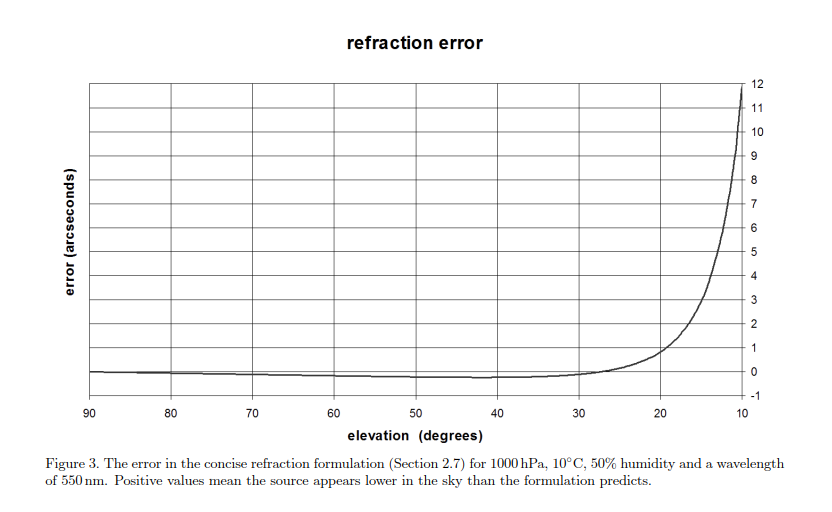When pointing and tracking accuracy are critical.
Placing radio antennas and large telescopes around the world is expensive. And once installed, their operating costs can be astronomical.
The most expensive antennas and telescopes are those that do not operate reliably. Among the reasons for failure, don’t let pointing or tracking be one of them.
That’s where TPoint™ Professional comes in. Along with a suite of advanced software tools, it delivers extremely accurate pointing and tracking. Reliably, night after night.
Note: To explore the TPoint version that integrates with TheSky™ software, please click here.
What is TPoint Professional?
TPoint™ Professional is a unique application that analyzes telescope pointing with the goal of identifying and correcting errors inherent in all telescopes. It can work in conjunction with a suite of advanced software products to perform additional functions, including improving your mounting’s tracking accuracy.
TPoint is used by professional observatories worldwide, including the Keck telescopes, GBT, Gemini, ALMA, AAT, ARC, WIYN, WHT, UKIRT, JBO, IRTF, NSST, ESO, CTIO, SOAR, MMT, Magellan, and LBT and is applicable to all mount designs, including equatorial, altazimuth, or generalized gimbals.
Its principle of operation is simple — observe stars spread around the sky while recording the telescope’s readouts on each occasion — then feed the information into TPoint. TPoint identifies and quantifies repeatable errors in the instrument and builds a pointing model. Using this pointing model, the telescope control system effectively compensates for various ill-effects which dramatically reduce pointing errors.
TPoint is a must for unattended robotic telescopes. CMOS/CCD observing becomes a simple matter of commanding the telescope, carrying out the exposure and then, on readout, finding the image of the object under study consistently centered in the frame. With the best observatory instruments, TPoint helps maintain all sky pointing accuracy at the 1-2 arcsecond level, allowing fully automatic acquisition. High-end amateur instruments routinely achieve 10 arcsecond performance and better.
Apart from making target acquisition swift and assured, a less obvious benefit of TPoint is that with appropriate telescope control software (for example based on the TCSpk or CPK libraries) tracking can be significantly improved. This comes about through the continuous correction of mechanical effects such as cyclic errors in setting circles and encoders. For equatorial mounts, visibility of the pole is not necessary. TPoint determines polar axis and reports the adjustments that need to be made to best align the polar axis based on your observing goals.
TPoint Professional uses a traditional command-based user-interface. It runs under Windows, macOS, Linux, and by special arrangement, it can also be built for other Unix platforms. A different TPoint version also runs Windows, macOS, and Linux and is fully integrated with the telescope-control facilities contained in Software Bisque’s TheSky™ software — learn more here.
TPoint will significantly improve your instrument’s pointing performance. After telescope modeling, a telescope which previously required painstaking use of finding charts and manual searching, or time-consuming preliminary acquisition of a nearby bright star, can consistently place faint objects directly onto the center of the sensor’s field of view or high-power eyepiece. When used in conjunction with TCSpk or CPK, the same TPoint model will significantly improve the mount’s tracking accuracy by correcting errors caused by tube flexure, polar alignment errors, differential atmospheric refraction and more.
The comprehensive TPoint user guide is available upon request.
Telescope Pointing
Telescope Pointing was written by Patrick Wallace, the world’s foremost expert on telescope pointing analysis.
Why Accurate Pointing is Non-Trivial
The following article was written by Patrick Wallace, author of TPoint software technologies, and the world’s foremost authority on telescope and antenna pointing.
Products
TPoint Technology Product Overview
Each TPoint product is described below. Note that some of the products require the presence of others as a prerequisite.
TPoint™ Professional
Also known as ProTPoint™, TPoint Professional is an analysis tool that takes telescope pointing observations and computes a mathematical model that predicts the various systematic errors in the telescope and mount. The command-line application is supplied as an executable (for Windows, macOS, or Linux), together with a 160-page user guide. TPoint Professional is licensed on a per instrument basis. The cost of the license depends on the aperture or size of the instrument.TPoint Professional itself does not control a telescope as that is the responsibility of the telescope control system (a) to carry out pointing tests and to log the results in one of the forms that TPoint accepts, and (b) to implement pointing corrections according to the model that TPoint finds. The products TCSpk, TPC and CPK (see below) support these aspects.
In cases where the expense can be justified, TPoint is also available as ANSI C source code with an accompanying 235-page manual. The resulting library (TPTLIB) can be used to add TPoint functionality to the user's applications. SLALIB (see below) is a prerequisite.
TCSpk™
The Telescope Control System Pointing Kernel (TCSpk™) is a comprehensive and rigorous telescope pointing kernel, aimed at developers of telescope or antenna control-systems for professional astronomy and space applications. It provides extremely accurate and sophisticated algorithms for controlling pointing and tracking, including provision for autoguiders, tip-tilt optics and instrument rotators. TCSpk is licensed in ANSI C source code form (just under 100 functions) together with a 300-page programmer’s manual. SLALIB is a prerequisite.
TPC
The Telescope Pointing Corrector library is for those with existing telescope or antenna control-systems and wish to add TPoint pointing and tracking corrections. It is licensed in ANSI C source code form and comes with an 80-page manual. SLALIB is a prerequisite.
CPK
The Concise Pointing Kernel library is for telescope or antenna projects that need a lightweight solution of modest accuracy. It performs the whole transformation from a star’s catalog position to the mount pointing demand and achieves and achieves an overall computational accuracy of 2 arcseconds while being fast enough to run at servo rates. CPK is licensed in ANSI C source code form, together with a 61-page manual. An introduction to the algorithms used is here.
SLALIB™
The SLALIB library, which comprises 216 functions, provides the software developer with a wide range of accurate and reliable positional-astronomy functions. SLALIB is used by professional astronomers worldwide and is at the heart of almost all the control systems for telescopes over 3-meter-aperture developed during the past several decades. It is licensed in ANSI C source code form and includes a 385-page programmer’s manual.
IPHASE™
IPHASE is a TPoint-like package for analyzing optical path-length in 2-telescope interferometers. Given delay-line readings for different stars, the IPHASE package determines the geometry of the interferometer, including the relative locations of the two telescopes or antennae and various runout effects in their mountings.
The interferometer control system can use this information to improve the accuracy with which it can set the delay lines, speeding up fringe acquisition, especially for faint objects. IPHASE is a highly specialized tool, of interest to professional observatories which operate, or are developing, interferometer systems. Like TPoint, a range of versions is available, including executables (for Windows, macOS and Linux) and source licenses. SLALIB is a prerequisite.
TPoint Licensing
- Each product listed above is licensed on a per instrument basis.
- TPoint Professional includes a USB security key that can be plugged into the computer that is controlling the instrument.
- TPoint source code licensing, of interest to major projects which need to guarantee long-term in-house support, is more expensive and is licensed on strict non-disclosure terms.
- Licensing arrangements exist for, respectively, (i) non-profit astronomy institutes and individuals, and (ii) telescope or other instrument manufacturing companies and other commercial users. To inquire about licensing TPoint and other products, please email us at Systems@Bisque.com.
FAQs
Frequently Asked Questions
See the answers to frequently asked TPoint Technology questions below.
Q. What is the cost for licensing TPoint?
A. Expand TPoint Licensing above for the available licensing options.
Q. What is the difference between the Concise Pointing Kernel (CPK) and the Telescope Control System Pointing Kernel (TCSpk)?
A. TCSpk is a complete telescope and rotator pointing and tracking kernel that can be used to command the al/az or HA/Dec plus instrument rotator to any position in the imaging train. CPK is a lighter weight implement that can achieve up to 2 arcsecond accuracy for large antennas or projects that do not require the full TCSpk.
Q. Are TPoint and/or CPK flexible enough to work with any mount?
A. Yes. Although both equatorial and altaz are supported, these are merely special cases of a "generalized gimbal", with two axes nominally at right-angles. For that matter, either of the common cases can be rotated by several degrees without the final pointing accuracy being degraded: the only limitation is that a two-axis gimbal is assumed. For example it would be feasible to mount an altaz tracker on a tilting platform to accommodate satellite passes close to zenith; the platform tilt would be taken account of simply by changes to certain pointing-model terms.
Q. What coordinate systems/transformations does TPoint support?
A. TPoint is layered on the SLALIB/C positional-astronomy library that has a wide range of such capabilities.
Q. Are corrections automatically applied by TPoint? If so, can they be disabled?
A. In general, yes. TPoint and TCSpk or CPK are interested only in the direction of the incoming light. Although for star sightings a natural sky coordinate system is ICRS [RA,Dec] (effectively mean J2000.0 [RA,Dec]) it would be perfectly in order to drive the system with raw observed [Az,Alt] generated by your application.
Q. How does TPoint, CPK and TCSpk handle refraction?
A. TCSpk uses a state-of-the-art raytracing technique that works down to the horizon and a little beyond, taking full account of color, pressure, humidity, temperature, site location and tropospheric lapse rate. The default implementation of CPK uses less-accurate, but fast algorithm that computes refraction, but can optionally use the same code.

Q. Can CPK and TCSpk apply a mount model between sky Alt, Az and mount Alt, Az positions?
A. Yes, in both directions. The model is rigorously invertible and there are functions that perform both the sky-to-encoders transformation and the encoders-to-sky transformation. But in the latter case note that except in mid-slew cases the best estimate of where the telescope is pointing is simply where it has been asked to point.
Q. Is TPoint documentation available?
A. Yes. TPoint Technology comprehensive documentation meticulously describes each component to helps you implement it quickly.
- TCSpk user guide (305 pages)
- TPoint Professional user guide (162 pages)
- CPK user guide (60 pages)
- SLALIB user guide (286 pages)
- Telescope Pointing Corrector (TPC) Programmer’s Manual (79 pages)
About TPoint's Author

Patrick T. Wallace was born in 1946 in England and has a degree in astronomy from University College in London. After working in industry as a computer programmer, he joined the Anglo-Australian Telescope project in 1973 and was instrumental in the development of their 3.9 m telescope’s control system.
Patrick was part of several AAT observing campaigns, including the first optical detection of the Vela Pulsar. From 1980 to 2010, he managed the UK Starlink Project which provided computers and software for astronomical data analysis. During this period he retained his interest in telescope control and, to keep his hand in as a programmer, developed algorithms and software privately.
He acted as a consultant to ESO and the Keck Observatory among others, specializing in accurate pointing. TPoint, Patrick’s commercial package, is used widely by both professionals and amateurs, and in the 1990s was adopted by Software Bisque and incorporated into TheSky. The final years of his day-job career were spent working in fundamental astronomy and in IAU standards work, including the SOFA initiative.
In 2017, Software Bisque acquired TPoint and continues to enjoy a strong working relationship with Patrick.
Patrick also continues to provide software and consultancy services through his company, Tpoint Consulting and continues refining TPoint.
When not doing that, he plays the violin, flies a glider, and takes photographs of his grandchildren.